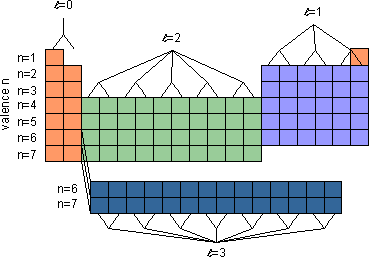Factors affecting the valence shell. Anything that influences the valence electrons will affect the chemistry of the element.
|
Factors (in order of decreasing importance) |
Effect |
| 1. | valence principal quantum number n |
Larger n means a larger valence shell (because n controls the size of orbitals) |
| 2. | nuclear charge Z |
Larger Z means a smaller valence shell (because higher positive charge on the nucleus attracts the valence electrons, and pulls them inward) |
| 3. | number of core electrons |
More core electrons means a larger valence shell (because highly penetrating core electrons repel valence electrons, and push them farther from the nucleus) |
|
 ; view the table as an ordered database of element properties.
; view the table as an ordered database of element properties.
 in:
in:
 for atoms.
for atoms.

 ) for the last
) for the last 
 Na+(g) + e-
Na+(g) + e- H = +496 kJ
H = +496 kJ